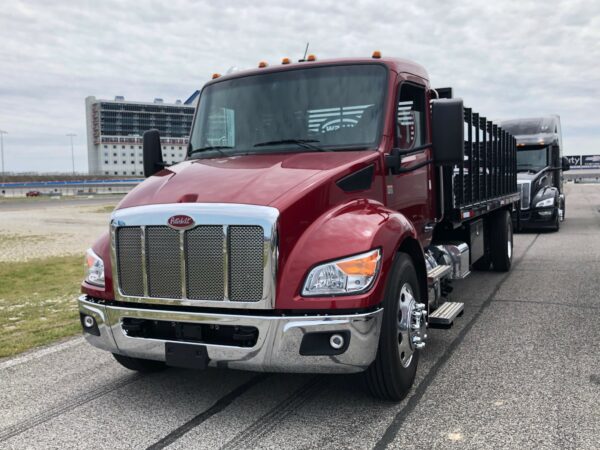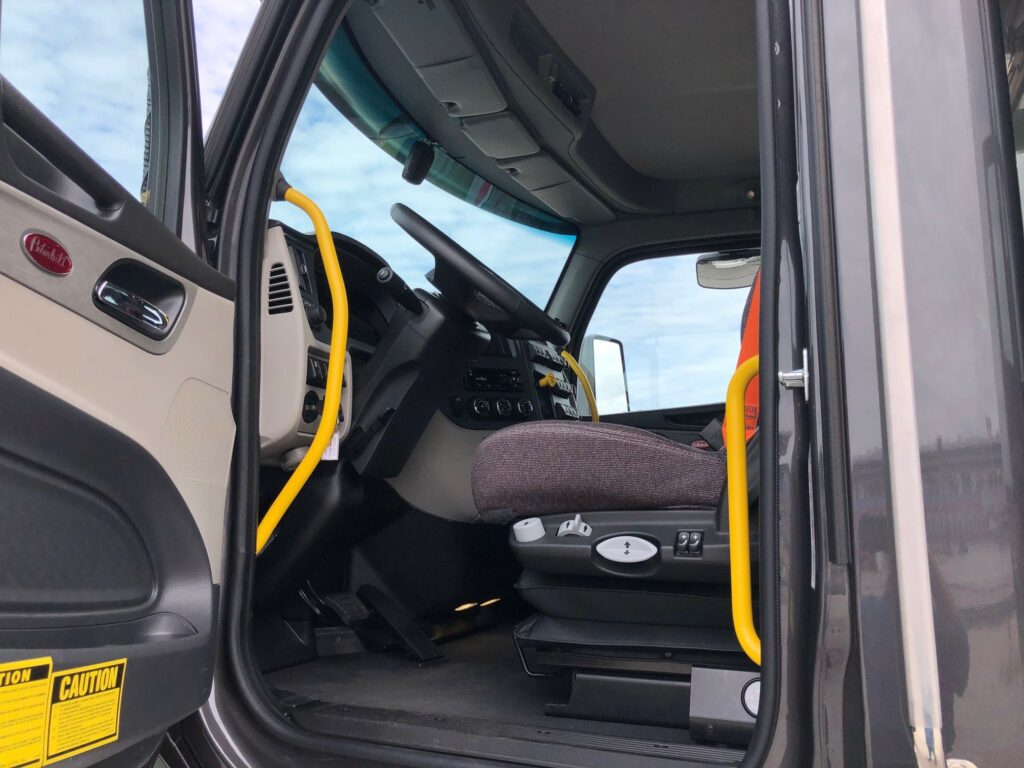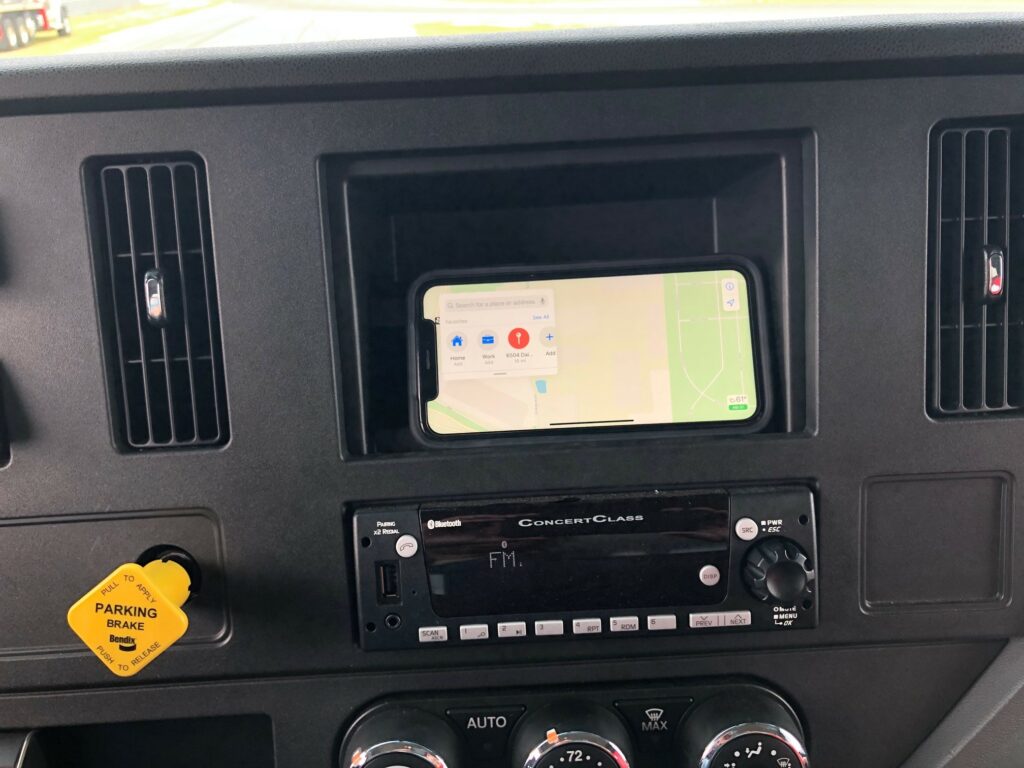Peterbilt embraces a ‘total rethink’ with MD lineup
Peterbilt has followed up on the virtual launch of its medium-duty truck lineup, giving North American journalists a chance to spend some time behind the wheel to see how the OEM has reimagined the vehicles.
The OEM hosted a day of briefings, walkarounds and drives at the Texas Motor Speedway, highlighting the new Model 535 and Model 536 trucks designed for the non-CDL lease and rental markets, and the Model 537 and 548 trucks for the Classes 7 and 8 segments.
Power options for the new trucks are focused on the latest versions of the PX family of diesel engines, built by Peterbilt’s parent company, Paccar. These include the PX-7 and PX-9 engines, both of which feature longer oil and fuel filter service intervals, and fuel economy improvements. The updated PX-9 also logs higher torque ratings in the 260-, 350- and 360-horsepower versions, as well as a lower torque drop-off speed.
In another major advancement, Paccar has also introduced a vocationally focused automatic transmission. Designed by ZF, which has a long history in Europe and Asia, the new Paccar TX-8 is a fully automatic model (equipped with a torque convertor) featuring eight gears and the ability to monitor changes in road grade, vehicle acceleration, torque demand, weight and engine load.
The transmission delivers automotive-like shifting with up to 5% better fuel economy, according to medium-duty product manager Phil Hall, noting the transmission also features an automatic park lock, and a twin torsional damper that enables early first gear lockups for smoother shifts and faster acceleration.

A ‘total rethink’
Then he turned writers loose on the speedway’s Grand Prix course to see how his engineering team created a truck that he called a “total rethink” for Peterbilt.
“These new trucks are a clean-sheet design,” Hall noted. “We understand that the medium-duty market – and our customers who use these trucks – are changing. To meet these changing expectations and ways of working, our team settled on a ‘human-centered’ design.”
Hall said that in 1995, when Peterbilt delivered its last generation of medium-duty trucks, the company was focused on “quantitative” design process. “For this new medium-duty lineup, I challenged our design team to think in terms of a ‘qualitative’ engineering process,” Hall explained. “This meant focusing on customer need and understanding why they do things in certain ways when they’re using our trucks.”
To accomplish this goal, Hall’s team met with hundreds of fleet owners and drivers to obtain key insights on how they work today – and how they believe they will be working in the future. This approach led to what Hall calls an “all-intuitive” interior design, guiding everything from the placement of dials, switches and gauges, to the “massive” storage spaces in the cabs.
While the trucks are packed with new technology, his team – and that vital customer and driver input – wanted to ensure the technology serves a purpose when it comes to working safer and more efficiently.
“Outside the truck, daily maintenance and fluid checks are in easy access points for quick and easy checks,” Hall said. “And it only takes five minutes to change out a headlight on the trucks. Inside the trucks, ergonomics dictated everything we did – from getting in and out of the vehicles, to the haptics on the new display screen and other controls, to the advanced safety systems and how they perform to keep drivers safe on the road. And that’s why we feel this new model lineup will set a new standard for medium-duty trucks in North America. Not just for the first lifecycle. For multiple lifecycles as they age.”

Innovative safety
For our first-impression test drives around the Texas Motor Speedway Grand Prix track, Peterbilt assembled all of the medium-duty models spanning Classes 5 through 8, with an assortment of Model 535 and 536 trucks to choose from.
Opening the door to a red, stake-bodied Model 536, the first thing that jumped out at me was the cab interior, which is noticeably wide and airy, with excellent views over the sharply slanted nose and out to the sides. The new seven-inch graphic display screen in the center dash cluster was also impressive, with brilliant, infinitely adjustable graphics and gauges. The design is matte-finished and coated to protect against glare and easy to set and scan while on the road.
Hall told us his design team spent a lot of time keeping ambient noise levels low inside the new cabs, and their work was apparent when I fired up the PX-9 diesel engine up front and allowed it to settle into idle. There’s remarkably little exterior noise filtering through to the inside of the truck. Conversations with passengers don’t require any yelling, and outside shouts, warnings and commands can easily be heard and understood even with the big Paccar diesel rumbling away up front.
Out on the track I was impressed with just how nimble the Model 548 was, tracking effortlessly through the twists and turns on the Grand Prix course with minimal steering effort. The truck tracks with minimal steering effort, brakes well, and has plenty of low-end power on hand for quick acceleration. Cruise-speed distances were limited, of course, due to the track layout. But the truck is remarkably smooth and quiet at near-highway speeds and with excellent brake response when it’s time to check up and enter a curve.

A passenger car feel
Moving down into a Class 5 Model 535, with Hall riding shotgun in the passenger seat, highlighted the passenger-car-like feel that he and his team looked to introduce. At times the truck felt more like a big, even luxurious, SUV than a work truck, with excellent acceleration from the Paccar PX-7, and silky-smooth shifts from the new TX-8 automatic transmission. Steering inputs are indeed car-like, with the truck snaking effortlessly through the road course, with impressive braking and acceleration characteristics.
As on the Model 536, the cab is roomy and well lit, and there are numerous little storage nooks and crannies within easy reach, including an innovative storage bin underneath the passenger-side seat that can be easily accessed from ground level.
There was one little touch inside the cab that I felt truly showcased how much thought Peterbilt engineers put into these new trucks. It’s a simple rectangular cellphone storage nook in the center dashboard. Hall likes to keep a cell phone handy so he can easily view maps while driving his own vehicles, so he inspired this nook that holds a smartphone in a horizontal position. It’s a cool but simple feature, and one that I suspect will be greatly appreciated by busy drivers who find themselves in unfamiliar surroundings and heavy traffic.
The new trucks take full advantage of technology in a smart, transformative way that both fleets and drivers alike will find safer, more comfortable, and more efficient as traffic, freight and construction work all ramp up in the near future.
Have your say
This is a moderated forum. Comments will no longer be published unless they are accompanied by a first and last name and a verifiable email address. (Today's Trucking will not publish or share the email address.) Profane language and content deemed to be libelous, racist, or threatening in nature will not be published under any circumstances.
OMG. A cell phone nook is a big deal a qualitative design. Give me a break. The nook location requires driver to look down and to the right to view…eyes off road…distracted driving…Jack your better than following that sales pitch..aren’t you?
Do what 90% of drivers do , buy a phone pedestal for dash…jack you have seen those right?